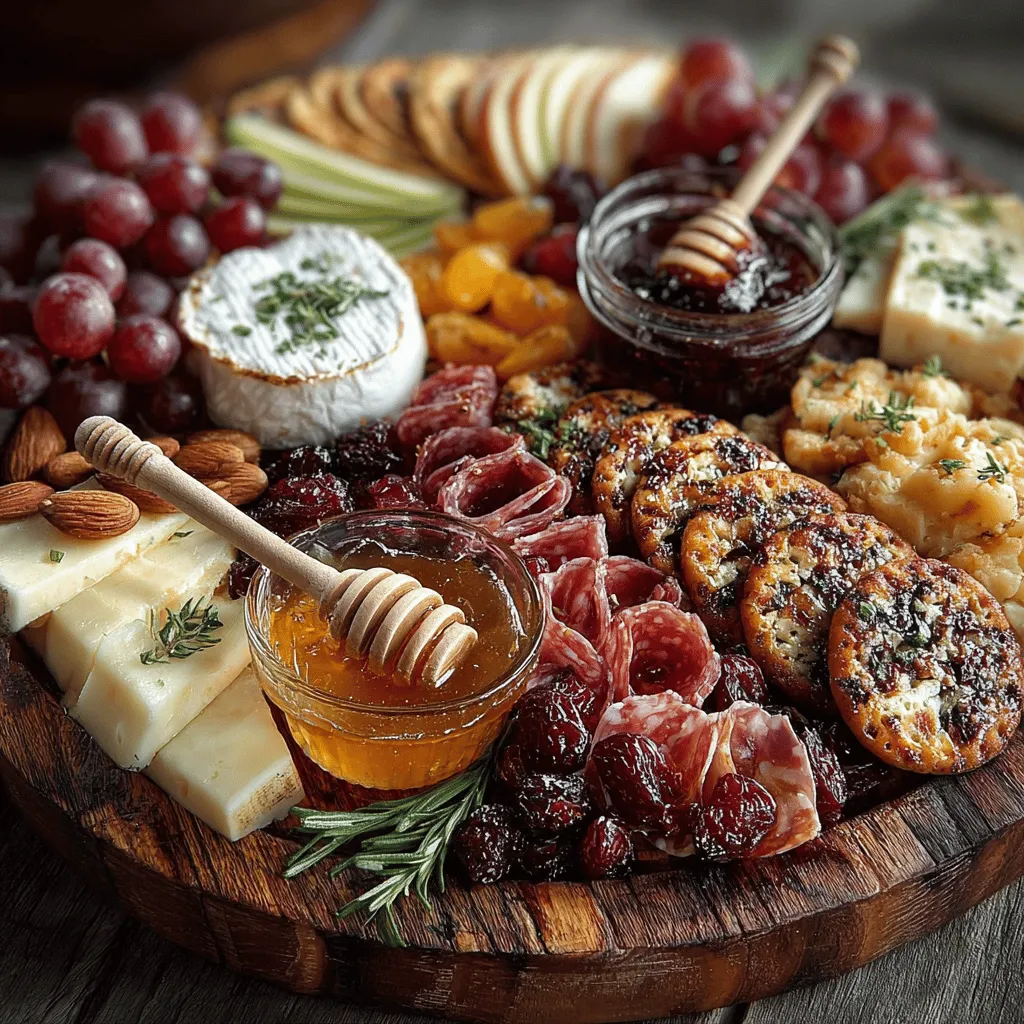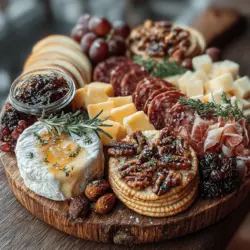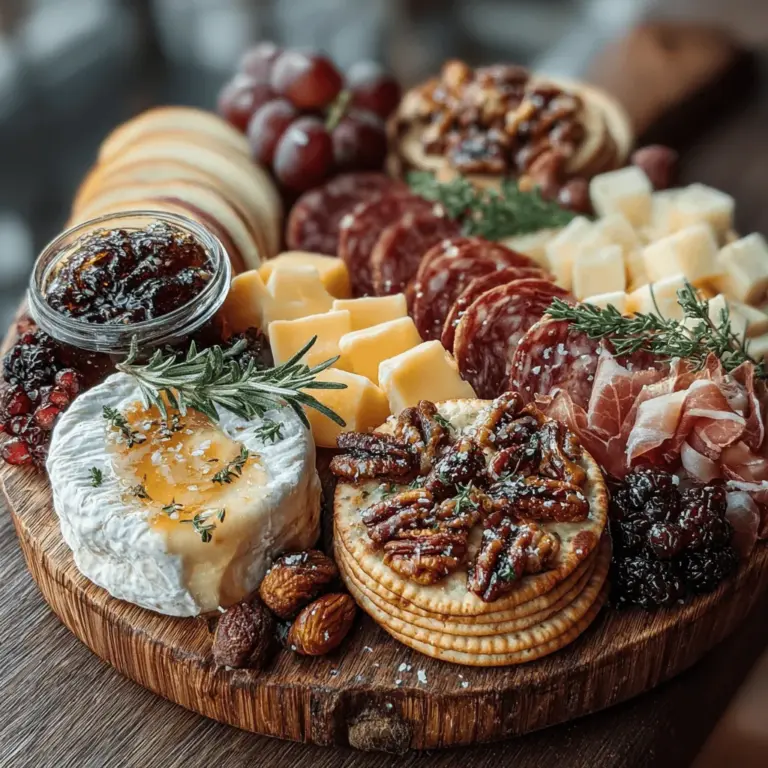Introduction
In the realm of culinary artistry, few creations rival the allure of a dreamy charcuterie board. This exquisite spread not only tantalizes the taste buds but also captivates the eye, transforming any gathering into a memorable occasion. Whether you’re hosting a casual get-together, celebrating a festive milestone, or enjoying a cozy evening at home, a well-crafted charcuterie board serves as the centerpiece that invites conversation and sharing.
Originating from the French tradition of preserving meats, the charcuterie board has evolved into a versatile and artistic display of gourmet ingredients. It showcases a variety of cured meats, artisanal cheeses, fresh and dried fruits, and crunchy nuts, all artfully arranged to create a feast that is as pleasing to the eye as it is to the palate. This article will guide you through the process of assembling a stunning charcuterie board that not only impresses your guests but also elevates your hosting game to new heights.
Understanding Charcuterie Boards
The term “charcuterie” comes from the French word for “cooked meats” and historically refers to the art of preparing and assembling cured meats, such as sausages and pâtés. Over the years, this concept has expanded beyond just meats to include a wide range of accompaniments, making charcuterie boards a culinary canvas for creativity.
At its core, a charcuterie board is a curated selection of ingredients that harmonize in flavor and texture. This includes various types of meats, cheeses, fruits, nuts, and condiments, all arranged in a manner that invites enjoyment and exploration. The art of presentation plays a crucial role in the success of your charcuterie board. Thoughtful arrangement and attention to color contrast and texture can transform ordinary ingredients into a spectacular feast that sparks curiosity and conversation.
Selecting Your Ingredients
Creating a dreamy charcuterie board begins with selecting the right ingredients. Each component should contribute to the overall flavor, texture, and visual appeal of the board. Here’s a detailed breakdown of how to choose the perfect elements for your spread.
Choosing the Right Cured Meats
Cured meats are the foundation of any charcuterie board, providing rich flavors and a variety of textures. Here are some popular options to consider:
– Prosciutto: This Italian dry-cured ham is known for its delicate, salty flavor and melt-in-your-mouth texture. When selecting prosciutto, look for thinly sliced pieces that are slightly translucent, indicating high quality.
– Salami: With countless varieties available, salami can add a robust flavor to your board. Look for artisanal options that feature unique spice blends or regional specialties, such as Genoa or soppressata.
– Chorizo: This Spanish sausage, seasoned with paprika, offers a spicy kick that can enhance the overall flavor profile of your charcuterie board. Opt for a quality chorizo that is made with natural ingredients for the best taste.
When sourcing cured meats, consider visiting local delis or specialty stores where you can find fresh, high-quality products. Ask for recommendations and sample different varieties to discover what resonates with your palate.
Picking the Perfect Cheeses
Cheese is another central component of a charcuterie board, and the right selection can elevate your spread to new heights. To achieve a balanced flavor experience, incorporate a range of cheese types:
– Brie: This soft cheese is creamy and mild, making it a wonderful counterpoint to more robust meats. Its buttery texture invites pairing with fruits and nuts.
– Aged Cheddar: The sharpness of aged cheddar adds complexity to your board. Look for varieties with rich, nutty flavors that can stand up to the saltiness of cured meats.
– Goat Cheese: With its tangy flavor and creamy texture, goat cheese can provide a refreshing contrast to the other ingredients. Consider incorporating flavored goat cheese, such as herb-infused or honey-drizzled options, for added interest.
When choosing cheeses, aim for a variety of textures and flavor profiles. A good rule of thumb is to select a soft cheese, a hard cheese, and a blue cheese, ensuring a well-rounded experience.
Incorporating Fresh and Dried Fruits
Fruits play a vital role in balancing the richness of meats and cheeses on your charcuterie board. They provide a natural sweetness and refreshing acidity that can enhance the overall taste. Here are some excellent choices:
– Grapes: These bite-sized treats are easy to add and come in various colors, providing visual appeal. Choose a mix of red and green grapes for a vibrant touch.
– Figs: Fresh figs are a luxurious addition, while dried figs offer a chewy texture and concentrated sweetness. Both options pair beautifully with cheese.
– Apples: Sliced apples add a crisp texture and a tart contrast to rich cheeses. Opt for varieties like Honeycrisp or Granny Smith for a refreshing crunch.
Using seasonal and local fruits not only enhances the flavor of your charcuterie board but also supports local farmers and sustainable practices.
Adding Variety with Nuts and Crackers
The texture of your charcuterie board is just as important as the flavor. Incorporating a variety of nuts and crackers can provide the necessary crunch to balance the softness of cheeses and meats:
– Nuts: Almonds, walnuts, and pistachios are excellent choices that add richness and complexity. Consider using both salted and unsalted varieties to offer different flavor experiences.
– Crackers: Choose a mix of textures, from crispy water crackers to hearty whole grain options. Look for artisanal brands that offer unique flavors, such as rosemary or olive oil, to elevate the experience.
Striking the right balance with your selection of nuts and crackers can enhance the overall enjoyment of the board and encourage guests to explore different combinations.
Enhancing Flavor with Honey, Jams, and Olives
To take your charcuterie board to the next level, consider adding sweet and savory elements that can complement the other components:
– Honey: A drizzle of honey can enhance the flavors of both cheeses and cured meats. Choose high-quality, raw honey for the best taste, and consider varieties infused with herbs or spices for a unique twist.
– Jams: Fig jam or a seasonal fruit preserve can provide a delightful contrast to savory flavors. These sweet accompaniments can be spread on crackers or paired with cheese for an exquisite experience.
– Olives: Adding a selection of olives can introduce briny flavors that cut through the richness of meats and cheeses. Consider including a mix of green and black olives for variety.
These elements can bring your charcuterie board to life, offering guests a chance to experiment with flavor pairings and discover new favorites.
Crafting Your Dreamy Charcuterie Board
Once you have selected your ingredients, the next step is to think about presentation. Choosing the right board can set the tone for your charcuterie spread:
– Board Selection: Opt for a wooden or slate board that complements your aesthetic. Wooden boards offer a rustic charm, while slate provides a modern touch. Ensure your board is large enough to accommodate all your ingredients without feeling overcrowded.
– Arrangement Tips: Begin by placing the larger items, such as cheeses and meats, on the board first. Then fill in the gaps with fruits, nuts, and crackers. Consider using small bowls for honey, jam, or olives to create defined spaces for these items.
The art of crafting a dreamy charcuterie board lies in the details. By carefully selecting and arranging your ingredients, you can create a stunning visual display that is sure to impress your guests and provide a memorable culinary experience.

Creating a stunning charcuterie board is not just about the flavors; it’s an art form that brings people together over shared culinary experiences. With the right techniques and thoughtful arrangement, you can craft a display that delights both the eyes and the palate. Let’s dive into the details of how to bring your charcuterie board to life.
Importance of Board Size and Shape
When selecting the board for your charcuterie spread, size and shape play a crucial role in presentation and functionality. A larger board allows for more ingredients and creates a visually appealing spread, while a smaller board can be perfect for intimate gatherings.
Choosing the Right Board
– Material: Opt for wooden, marble, or slate boards, as they provide a beautiful backdrop for your ingredients.
– Shape: Rectangular boards provide more surface area for arrangement, while round boards can create a more casual, inviting feel.
Arranging the Cheeses
Cheese is the star of any charcuterie board, and how you arrange it can significantly impact the overall aesthetic.
Techniques for Slicing and Shaping Cheeses
1. Variety of Cuts: Use different slicing techniques to create visual interest. For hard cheeses like aged cheddar, cut into cubes or thin wedges. For soft cheeses, serve them whole with a cheese knife for spreading.
2. Cheese Shapes: Consider using different shapes such as triangles, squares, and slices to add dimension. A cheese log or wheel can also serve as a lovely centerpiece.
Strategic Placement for Visual Balance
– Color Coordination: Arrange cheeses in a way that complements the colors of your meats and accompaniments. For example, a creamy brie pairs beautifully with vibrant fruits.
– Height Variation: Place taller cheeses or stacked cheeses at different points on the board to create layers and depth, drawing the eye across the entire display.
Incorporating the Cured Meats
Next, it’s time to add cured meats, which add richness and flavor to your board.
Creative Folding and Stacking Techniques
1. Folding: Fold slices of prosciutto or salami into quarters, creating elegant fan shapes that add sophistication.
2. Stacking: For meats like pepperoni or chorizo, stack them in small piles to encourage guests to help themselves easily.
Ideas for Arranging Meats for Elegance
– Placement Patterns: Arrange meats in a circular pattern or in small groups to create a visual flow. This will also help separate flavors and allow guests to pick and choose.
– Contrasting Textures: Pair delicate meats with firmer cheeses to contrast textures and enhance the tasting experience.
Integrating Fruits and Nuts
Fruits and nuts provide a pop of color and a balance of flavors to your charcuterie board.
Methods for Scattering and Placement
– Fresh Fruits: Scatter grapes, figs, or apple slices around the board. For a tidier look, slice fruits like apples and pears just before serving to prevent browning.
– Nuts: Use clusters of nuts such as almonds or walnuts in small areas to create natural breaks between larger items.
Using Small Bowls for a Tidy Presentation
Incorporate small bowls for items that might run or be difficult to place directly on the board, such as olives or dips. This not only keeps the board looking organized but also encourages guests to serve themselves easily.
Creating Pathways with Crackers
Crackers serve both as a vehicle for your delicious toppings and as a visual component of your charcuterie board.
Tips for Arranging Crackers for Aesthetic Appeal
1. Layering: Place crackers in overlapping rows or stacks to create pathways across the board. This encourages exploration and adds a decorative element.
2. Variety: Use a mix of textures and flavors, such as crispy water crackers alongside hearty whole grain options.
Balancing the Spread with Easy Access for Guests
Ensure that crackers are easily accessible from all sides of the board. This will allow guests to navigate the board without feeling cramped, enhancing their experience.
Finishing Touches with Honey, Olives, and Herbs
The finishing touches can elevate your charcuterie board from good to extraordinary.
Importance of Garnishing for Aroma and Color
– Honey: Drizzle honey over cheese or place it in a small dish for dipping. Its sweetness contrasts beautifully with savory components.
– Olives: Scatter olives around the board for bursts of flavor and a salty kick.
How Fresh Herbs Enhance the Overall Experience
Incorporate fresh herbs such as rosemary or thyme around the board. Not only do they add a fragrant note, but they also introduce vibrant green tones that enhance the visual appeal.
Serving Suggestions for Your Charcuterie Board
To ensure your guests have the best experience, consider the following serving suggestions.
Pairing Recommendations
Ideal Wine Pairings with Different Meats and Cheeses
– White Wines: Pair crisp white wines like Sauvignon Blanc with lighter cheeses and cured meats.
– Red Wines: Opt for medium-bodied reds like Pinot Noir to complement richer cheeses and meats.
Suggestions for Non-Alcoholic Beverages That Complement the Flavors
– Sparkling Water: A simple sparkling water with a slice of lemon can cleanse the palate.
– Fruit Juices: Fresh juices, such as apple or pomegranate, can add a refreshing contrast to the savory elements.
Providing the Right Tools for Enjoyment
Importance of Toothpicks, Small Plates, and Serving Utensils
Ensure that your guests have easy access to toothpicks for picking up meats and cheeses, as well as small plates for convenient serving.
Suggestions for Creating a Comfortable Snacking Environment
Consider providing a comfortable seating area with cushions and a relaxed atmosphere. Ensure there are napkins available for guests to use as they indulge in the board’s offerings.
Conclusion
Creating a dreamy charcuterie board is more than just assembling ingredients; it’s an opportunity to express creativity and share cherished moments with friends and family. By thoughtfully selecting your ingredients, arranging them with care, and incorporating complementary flavors, you can craft a stunning centerpiece that invites guests to indulge in a delightful assortment of tastes and textures.
Enjoy the process of curating your charcuterie board, and savor each moment as you share your culinary creation with others. Whether for a festive gathering or a casual evening at home, this charcuterie board will undoubtedly be a highlight of the occasion. Dive into the flavors, embrace the artistry, and let your charcuterie board shine!

